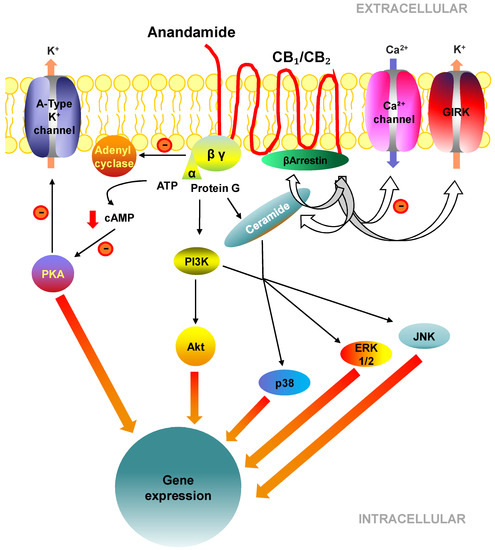 “L-dopa induced dyskinesia (LID) is a debilitating side-effect of the primary treatment used in Parkinson’s disease (PD), l-dopa. Here we investigate the effect of HU-308, a cannabinoid CB2 receptor agonist, on LIDs.
“L-dopa induced dyskinesia (LID) is a debilitating side-effect of the primary treatment used in Parkinson’s disease (PD), l-dopa. Here we investigate the effect of HU-308, a cannabinoid CB2 receptor agonist, on LIDs.
Utilizing a mouse model of PD and LIDs, induced by 6-OHDA and subsequent l-dopa treatment, we show that HU-308 reduced LIDs as effectively as amantadine, the current frontline treatment. Furthermore, treatment with HU-308 plus amantadine resulted in a greater anti-dyskinetic effect than maximally achieved with HU-308 alone, potentially suggesting a synergistic effect of these two treatments. Lastly, we demonstrated that treatment with HU-308 and amantadine either alone, or in combination, decreased striatal neuroinflammation, a mechanism which has been suggested to contribute to LIDs.
Taken together, our results suggest pharmacological treatments with CB2 agonists merit further investigation as therapies for LIDs in PD patients. Furthermore, since CB2 receptors are thought to be primarily expressed on, and signal through, glia, our data provide weight to suggestion that neuroinflammation, or more specifically, altered glial function, plays a role in development of LIDs.”
https://www.ncbi.nlm.nih.gov/pubmed/31669673
“Collectively, our findings suggest CB2 agonists offer a putative target to treat LIDs, with efficacy comparable to the frontline treatment amantadine. Our study suggests that targeting glial function may be an important strategy for developing therapies for treating LIDs, a major unmet need for PD patients.”
https://www.sciencedirect.com/science/article/pii/S0969996119303213?via%3Dihub

 “Cannabidiol (CBD) has been shown by our laboratory to attenuate experimental autoimmune encephalomyelitis (EAE), an animal model of multiple sclerosis (MS).
“Cannabidiol (CBD) has been shown by our laboratory to attenuate experimental autoimmune encephalomyelitis (EAE), an animal model of multiple sclerosis (MS). “Hypercholesterolemia (HC) is a major risk factor for cardiovascular (CV) diseases, that are the major cause of mortality worldwide.
“Hypercholesterolemia (HC) is a major risk factor for cardiovascular (CV) diseases, that are the major cause of mortality worldwide.
 “Hepatic fibrosis is the consequence of an unresolved wound healing process in response to chronic liver injury and involves multiple cell types and molecular mechanisms. The hepatic endocannabinoid and apelin systems are two signalling pathways with a substantial role in the liver fibrosis pathophysiology-both are upregulated in patients with advanced liver disease. Endogenous
“Hepatic fibrosis is the consequence of an unresolved wound healing process in response to chronic liver injury and involves multiple cell types and molecular mechanisms. The hepatic endocannabinoid and apelin systems are two signalling pathways with a substantial role in the liver fibrosis pathophysiology-both are upregulated in patients with advanced liver disease. Endogenous 

 “Medical
“Medical  “We used mouse microglial cells in culture activated by lipopolysaccharide (LPS, 10 ng/ml) to study the anti-inflammatory potential of
“We used mouse microglial cells in culture activated by lipopolysaccharide (LPS, 10 ng/ml) to study the anti-inflammatory potential of  “Parkinson’s disease (PD) and L-DOPA-induced dyskinesia (LID) are motor disorders with significant impact on the patient’s quality of life. Unfortunately, pharmacological treatments that improve these disorders without causing severe side effects are not yet available. Delay in initiating L-DOPA is no longer recommended as LID development is a function of disease duration rather than cumulative L-DOPA exposure.
“Parkinson’s disease (PD) and L-DOPA-induced dyskinesia (LID) are motor disorders with significant impact on the patient’s quality of life. Unfortunately, pharmacological treatments that improve these disorders without causing severe side effects are not yet available. Delay in initiating L-DOPA is no longer recommended as LID development is a function of disease duration rather than cumulative L-DOPA exposure. “The high frequency and painful profile of inflammatory oral lesions and the lack of an effective drug protocol for their management stimulate the search for pharmacological alternatives for the treatment of these conditions.
“The high frequency and painful profile of inflammatory oral lesions and the lack of an effective drug protocol for their management stimulate the search for pharmacological alternatives for the treatment of these conditions.  “T helper (Th)-17 mediate inflammation in both peripheral tissues and the central nervous system. Signal transducer and activator of transcription factor3 (STAT3) is required for Th-cell pathogenicity and its activation in the brain has been demonstrated during the acute phase of experimental autoimmune encephalomyelitis (EAE) through the mammalian target of rapamycin (mTOR) signaling. Rapamycin (RAPA), an inhibitor of mTOR, can drive Forkhead box P3 (FOXP3+) induction as a regulatory factor.
“T helper (Th)-17 mediate inflammation in both peripheral tissues and the central nervous system. Signal transducer and activator of transcription factor3 (STAT3) is required for Th-cell pathogenicity and its activation in the brain has been demonstrated during the acute phase of experimental autoimmune encephalomyelitis (EAE) through the mammalian target of rapamycin (mTOR) signaling. Rapamycin (RAPA), an inhibitor of mTOR, can drive Forkhead box P3 (FOXP3+) induction as a regulatory factor.